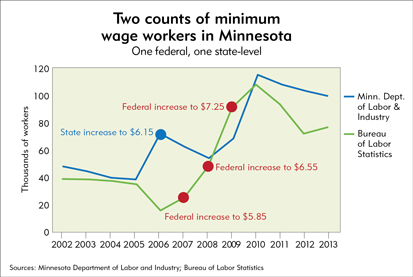To those interested in general employment trends, federal and state agencies offer a wealth of data. But tracking minimum and near-minimum wage jobs and workers is less straightforward and comes with methodological trade-offs.
The most comprehensive employment data—such as those from the federal Quarterly Census of Employment and Wages—typically focus on occupations or industry sectors, rather than wages. For data on wages (for either jobs or workers), one has to turn to federal sources that offer useful snapshots, but can introduce methodological caveats related to sampling and other matters.
For example, the federal Bureau of Labor Statistics generates an annual report on the number of workers earning at- or below-minimum wages, which includes state-level estimates, from the Current Population Survey, a monthly survey of households conducted by the U.S. Census Bureau. These figures apply the federal minimum wage when estimating job numbers even where higher or lower minimum wages are in force at the state level. This can create measurements that do not reflect actual levels for a given state, particularly in cases where a state’s minimum wage is higher than the federal minimum.
For example, Montana’s minimum wage has regularly (but not universally) exceeded the federal minimum since 2007 and currently stands at $7.90. As a result, BLS estimates of minimum wage workers in Montana systematically undercount minimum wage workers in the state because (by law, save for certain exemptions) most workers had to be paid more in Montana than the federal minimum over most of this period. In 2012, for example, the BLS estimated that Montana had about 4,000 workers at or below the federal minimum wage of $7.25; Montana Department of Labor sources identified 12,300 workers below the state minimum wage at the time of $7.65.
Minnesota offers more evidence that counting minimum wage jobs might be more art than science. Its minimum wage was temporarily higher, at $6.15, from 2006 to 2008, when the federal minimum reached $6.55. Though the official Minnesota minimum was technically lower at this point, state law essentially tied wages to the federal minimum except for narrowly defined instances (for example, annual sales could not exceed $625,000 and businesses could not engage in interstate commerce, which precludes the ability to accept credit card payments).
Yet even when Minnesota’s effective minimum wage mirrored the nation’s, counts of such workers by these separate federal and state data agencies have varied considerably, especially since 2011 (see chart).
Estimates of the number of jobs at or near $10 an hour—a common target for new minimum wage efforts—offer other caveats. For example, in 2012 there were almost 1.1 million jobs paying less than $9.50 an hour in Ninth District states, according to data from the Occupational Employment Survey, which covers all full-time and part-time wage and salary workers in nonfarm industries. These data were provided to the fedgazette from state labor information offices. OES data, however, are not comparable over time for methodological reasons.
The BLS also provided the fedgazette with unpublished, state-level estimates of the number of jobs below $10. Despite the higher wage threshold, these estimates (taken from the CPS and, thus, a population sample) counted about 100,000 fewer low-wage jobs in district states in 2012.
Related content
A minimalist picture
Outside the controversy of employment effects of higher minimum wages, the population of low-wage workers and jobs is changing in subtle ways
Ron Wirtz is a Minneapolis Fed regional outreach director. Ron tracks current business conditions, with a focus on employment and wages, construction, real estate, consumer spending, and tourism. In this role, he networks with businesses in the Bank’s six-state region and gives frequent speeches on economic conditions. Follow him on Twitter @RonWirtz.






